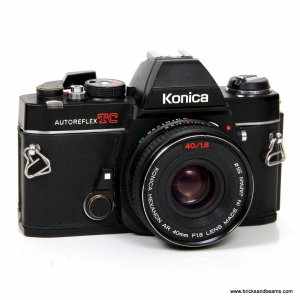So why then I did take a chance and buy a camera that might be an "old school" manual model when what I really want is an auto focus camera? The price. For the princely sum of $21.10 I won this camera in an auction. For that amount of money it was worth the risk. I don't have any other Konica brand cameras in my current collection. So even if this is a manual model, I can handle the modest cost of acquiring this one.
In the mid-70s, there was a strong trend towards smaller and lighter SLR cameras. Konica could not stand aside and introduced the Autoreflex TC in the spring of 1976. In Japan sold as ACOM-1, it is a completely new developed camera that is a lot smaller and lighter than all previously built SLRs from Konica – the F and the Autoreflex series. The body of the Autoreflex TC / ACOM-1 used many plastic parts for weight and cost savings, but the frame is still made of metal. The top cover with the prism housing and on later models the bottom plate also are completely cast from black plastic. This was quite daring at this time, but did not damage the success of the Autoreflex TC / ACOM-1. The plastic used is very resistant and looks well even after long usage. With the leatherette used on the Autoreflex TC / ACOM-1, Konica was less lucky. It tends to shrink strongly, which looks quite ugly on some cameras. Anyway, this is only a cosmetical fault and has no influence on proper function. The same leatherette was used later on the
The Autoreflex TC / ACOM-1 was available only in black.
There are several versions of the Autoreflex TC / ACOM-1: The early models have the old upper-case only Konica logo on the prism housing. Later models have the newer Konica logo with mixed upper- and lower-case letters. The film guides inside the camera body are slightly different for both versions.
There have been some other changes to the Autoreflex TC / ACOM-1 over time. While the upper-case logo was still in use, the back lock changed from a metal part with leatherette inlay to a plastic part. Some time after the new lower-case logo was put on the cameras, the formerly metal bottom plate with a punched serial number on the bottom side of the camera has been replaced by a plastic bottom plate with the serial number moved to the back side of the camera and filled with white paint.
Early versions:
Autoreflex TC
with upper-case logo
with upper-case logo
Autoreflex TC
with upper-case logo:
film guides
with upper-case logo:
film guides
Autoreflex TC
metal bottom plate
serial number on
bottom side
metal bottom plate
serial number on
bottom side
Later versions:
Autoreflex TC
with lower-case logo
with lower-case logo
Autoreflex TC
with lower-case logo:
film guides
with lower-case logo:
film guides
Autoreflex TC
plastic bottom plate
serial number on back
side
plastic bottom plate
serial number on back
side
The
Autoreflex TC / ACOM-1 was designed as an entry-level model and was
sold for a competitive price. It has limited features. The slowest
shutter speed on the Autoreflex TC / ACOM-1 is 1/8 second
(and B), it has no depth-of-field preview, and no multiple exposure
provision. The Autoreflex TC / ACOM-1 has been sold in large quantities
and is therefore quite often offered for sale second-hand. The cameras
are not as well-equipped as their predecessors, but as they are mostly
very cheap, they are an incredible bargain and good value for the money.
For normal everyday hobby photography or as cheap second body for using
differnt films, the features suffice, as the slow shutter speeds are
not used very often. As it is small and light, it is very well suited
for travel photography, to take it with you on a hike or a bicycle tour.
The
Autoreflex TC / ACOM-1 has an improved and brighter viewfinder, which
is equipped with split-image focussing and microprism ring.Especially for Autoreflex TC / ACOM-1, a new version of the Konica
Although many plastic parts were used, the Autoreflex TC / ACOM-1 is a rugged camera and takes abuse well. A new version of the Copal vertical travelling metal focal plane shutter, the CCS-M, was used in the Autoreflex TC / ACOM-1. It is just as long-living and cold weather-resistant as the previously used Copal Square-S.
Like many other cameras from this era, the Autoreflex TC / ACOM-1 uses mercury oxyde batteries for the light meter (2x type PX625). These batteries are not manufactured any more for environmental reasons and become more and more difficult to get.
This article courtesy of: www.buhla.de/foto/Konica/eTCHaupt.html


















